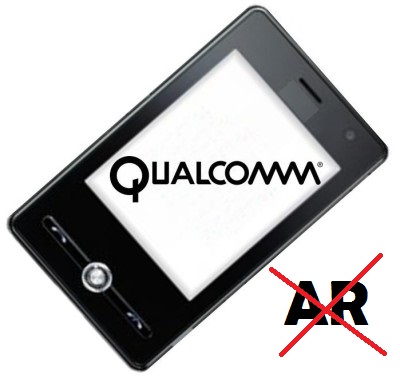Though the company had been working hard to create its own smartglasses, it has now dropped the tech.
With a number of new players in the augmented reality glasses sector – greatly pushed forward by the HoloLens by Microsoft – there have been some companies that have decided to step back or completely step out of this wearable technology space, and Qualcomm has now included itself among them.
Qualcomm has now decided to sell its AR technology business to PTC, an Internet of Things (IoT) firm.
The sale of the augmented reality business has occurred for an undisclosed sum, at the time of the writing of this article. It will include the Vuforia platform and SDK which makes it possible for partners and developers to be able to create their own AR experiences. Vuforia has been operational for about five years and has already been used for a number of sizeable projects, such as the Sesame Street mobile app, a miniaturized TARDIS, as well as the unique driving goggles that were created for Mini.
It isn’t entirely clear whether PTC intends to maintain the Vuforia augmented reality platform as it is.
 The company may also be interested in the underlying AR technology but it could alter it into something of a different nature. What is known is that the company has purchased the entire business, outright.
The company may also be interested in the underlying AR technology but it could alter it into something of a different nature. What is known is that the company has purchased the entire business, outright.
The purchase includes everything right down to the “developer ecosystem”, which means that it is more than likely that the projects that are currently in development will be able to progress forward as they have been, at least for the moment. Anything that should come of those projects will now be the property of the new owner.
From the side of Qualcomm, though it is evident that they are stepping out of the augmented reality space, it has still said that it intends to “continue to drive computer vision technology that will unlock a wide variety of applications for consumers and businesses around the world.” No additional specifics were provided with regards to precisely what that would entail, but that is not abnormal when it comes to this type of announcement.
This traditional activity for children can now bring on a 3D experience through mobile devices.
There isn’t anything new about having a child sit down with a box of crayons to bring a color to a black and white image in a coloring book, but researchers have now added augmented reality to the experience that could allow kids to see a three dimensional version of their projects through the screens of smartphones or tablets.
With the right AR app, the drawing is monitored and a child can enjoy an enhanced experience from the activity.
For example, if a child were to fill in a coloring book image of an elephant, just as he or she usually would, the augmented reality would make it possible for the colors to be filled in on a tablet or smartphone screen in real-time and can bring an animated, 3D version of that elephant to life on the device screen. That animation is then integrated into the video that the child can watch.
The augmented reality app maintains its core focus on the typical coloring activity while enhancing what is viewed.
 On top of the image the child is coloring, it creates an AR overlay on top of reality that enhances the engagement between the child and the image being colored. The preliminary user testing conducted by researchers was conducted with adults instead of children. What they determined was the majority of users said that their motivation for drawing within the coloring books was increased through the use of the app. In fact 80 percent of the participants in this study said that using the mobile app increased the connection that they felt with a character in the book.
On top of the image the child is coloring, it creates an AR overlay on top of reality that enhances the engagement between the child and the image being colored. The preliminary user testing conducted by researchers was conducted with adults instead of children. What they determined was the majority of users said that their motivation for drawing within the coloring books was increased through the use of the app. In fact 80 percent of the participants in this study said that using the mobile app increased the connection that they felt with a character in the book.
The researchers were from ETH Zurich, the EPFL university in Switzerland, and from Disney. They made a presentation of this new AR technology based experience in Fukuoka, Japan, at the IEEE International Symposium on Mixed and Augmented Reality (ISMAR 2015).
While the research is currently being shared primarily within scientific circles, it has already made its way through the tech transfer process, which has already brought to life the Disney Publishing Worldwide and Bendon partnership augmented reality product that was launched earlier in 2015, called “Disney Color and Play”.
 The company may also be interested in the underlying AR technology but it could alter it into something of a different nature. What is known is that the company has purchased the entire business, outright.
The company may also be interested in the underlying AR technology but it could alter it into something of a different nature. What is known is that the company has purchased the entire business, outright.
 On top of the image the child is coloring, it creates an AR overlay on top of reality that enhances the engagement between the child and the image being colored. The preliminary user testing conducted by researchers was conducted with adults instead of children. What they determined was the majority of users said that their motivation for drawing within the coloring books was increased through the use of the
On top of the image the child is coloring, it creates an AR overlay on top of reality that enhances the engagement between the child and the image being colored. The preliminary user testing conducted by researchers was conducted with adults instead of children. What they determined was the majority of users said that their motivation for drawing within the coloring books was increased through the use of the 